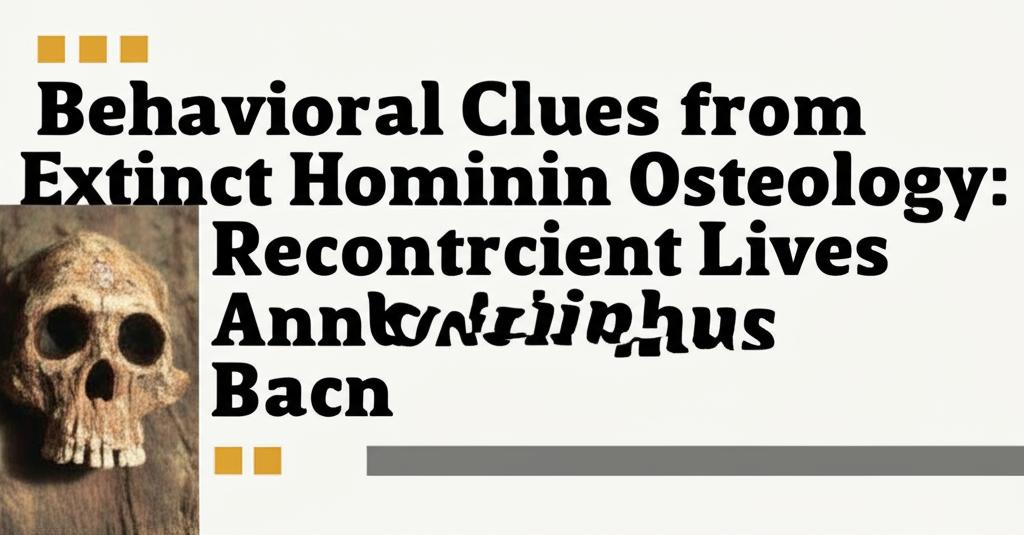The bones of our ancient relatives are far more than static relics; they are dynamic archives, offering profound insights into the daily lives, struggles, and triumphs of extinct hominins. By meticulously examining the form and structure (osteology) of these fossilized remains, researchers are piecing together narratives of behavior that span millions of years. Recent advancements in analytical techniques and a growing fossil record continually refine our understanding of how these ancient human ancestors and cousins moved, what they ate, how they interacted, and even how they perceived their world.
Locomotion and Environmental Interaction:The way a hominin moved through its environment is a fundamental aspect of its behavior, and bones are a primary source of this information. For instance, the internal structure of finger bones (phalanges) in Australopithecus sediba and Homo naledi reveals differing hand uses. A. sediba shows evidence of powerful grasping capabilities suited for arboreal locomotion, combined with features suggesting human-like manipulation. In contrast, while H. naledi also possessed curved finger bones indicative of climbing, their hand and wrist morphology shares traits with Neanderthals and modern humans, suggesting adaptations for intensified manual dexterity. The discovery of a 2-million-year-old Paranthropus robustus individual in South Africa, standing only about 3 feet 4.5 inches tall, with robust hip bones and more slender leg bones, suggests a life spent both walking bipedally on the ground and climbing trees, possibly to find food or escape predators like leopards, as indicated by tooth marks on the bones.
Fossilized footprints provide direct evidence of locomotion and, sometimes, even social behavior. Remarkable finds in Kenya's Lake Turkana region show tracks from two different hominin species, likely Homo erectus and Paranthropus boisei, walking along the same lakeshore around 1.5 million years ago. This discovery highlights the co-existence of different hominin groups and offers a snapshot of their simultaneous use of the landscape.
Dietary Clues and Tool Use:What our ancestors ate is a crucial piece of the puzzle, and their bones hold many clues. Cut marks on animal bones, made by stone tools, provide direct evidence of meat processing. Recent discoveries in Romania have pushed back the timeline for hominin activity in Eurasia to approximately 1.95 million years ago, based on such cut-marked bones. This suggests early humans were capable of butchering animals and were more adaptable to varied environments than previously thought, thriving in regions with seasonal fluctuations.
Sometimes, the cut marks are found on hominin bones themselves. A 1.45-million-year-old tibia from Koobi Fora, Kenya, exhibits the earliest known cut marks on a hominin postcranial bone. While it's unclear if this represents cannibalism or predation by another hominin species, it offers a tantalizing, if grim, glimpse into ancient interactions. The isotopic analysis of amino acids from bone collagen is another powerful technique, offering detailed insights into the types of plants and animals consumed, helping to reconstruct dietary behaviors and ecological niches.
Cognitive and Social Behavior:Beyond diet and locomotion, osteology can even hint at more complex behaviors. The study of endocasts (internal casts of the braincase) can reveal information about brain structure. Research on early Homo from Koobi Fora, Kenya, suggests that changes in the Broca's area of the brain, associated with speech in modern humans, may have implications for understanding the emergence of complex communication.
Even burial practices, long considered a hallmark of more recent human relatives like Neanderthals and Homo sapiens, are being debated for earlier hominins. Controversial research suggests that Homo naledi, with a brain about a third the size of ours, may have buried their dead and created cave engravings around 250,000 years ago in South Africa. If further substantiated, these findings would significantly reshape our understanding of the cognitive and symbolic capacities of these early hominins.
The Ever-Evolving Picture:The study of hominin osteology is a constantly evolving field. New fossil discoveries, like the facial bones of a hominin from Spain dating back 1.2 to 1.4 million years (tentatively classified as Homo affinis erectus), continually add new pieces to the human evolutionary puzzle. This individual's more projecting face, compared to the flatter face of Homo antecessor, along with associated stone tools and cut-marked animal bones, expands our knowledge of early hominin diversity and technological capabilities in Europe.
By integrating traditional anatomical studies with cutting-edge imaging techniques, isotopic analyses, and a growing understanding of developmental biology, paleoanthropologists are reconstructing ancient lives with increasing detail and accuracy. Each bone, tooth, and footprint holds the potential to reveal new behavioral clues, painting an ever-clearer, though still incomplete, picture of our extinct ancestors and their journey through time.

